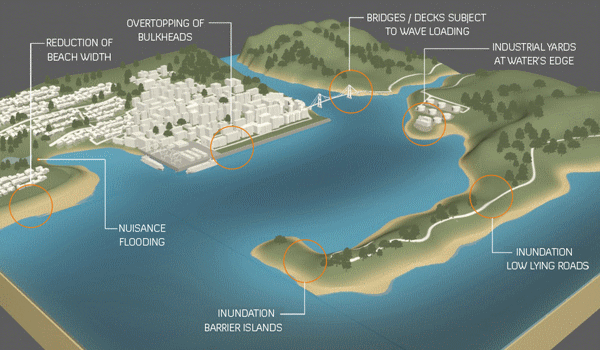Excerpt:
Last September, the U.S. Army Corps of Engineers unveiled its proposal to protect the greater New York and New Jersey metro area from the next catastrophic flood. It is an epic plan that includes dozens of miles of floodwalls, levees and berms along the shoreline and 12 storm surge barriers — arrays of movable gates — across entrances to waterways throughout the region. The plan is estimated to cost a staggering $52.6 billion. It’s by far the most expensive project ever proposed by the Corps.
The trouble is that despite its great ambitions, the Corps’s plan demonstrates the shortcomings of relying on massive shoreline structures for flood protection. If built, this plan could reverse the region’s decades-long effort to open up its waterfront for recreation while, at best, protecting only a small fraction of the region’s most vulnerable areas from devastating storm surge flooding.
Coastal storm flooding is a grave risk to the region, as we saw when Hurricane Sandy swept through, causing 60 deaths and more than $70 billion in damage. In terms of population at risk, New York City is the most vulnerable city in the country, according to Climate Central, a nonprofit research organization. As global warming raises sea levels, more of the region will be at risk, and the likelihood of Sandy-scale flooding will increase.
Other cities facing such risks — including Rotterdam, the Netherlands; London; and St. Petersburg, Russia — have built arrays of movable gates across the main entrances to their harbors. These highly effective and reliable harborwide surge barriers can protect large areas while leaving shorelines free for recreation and other uses. And they are an ideal fit for the geography of New York Harbor.
Central to the Corps’s proposal, by contrast, are 50 miles of 12-to-20-foot-high floodwalls, levees and other shoreline structures that would interfere with public access and connection to the water on long stretches of existing developed waterfronts and parks, including Hunters Point, Greenpoint, Manhattan’s West Side and downtown Jersey City.
Imagine bicycling up the Hudson River Greenway in Manhattan next to a concrete wall between you and Hudson River Park. Or straining to see the United Nations through occasional gaps in a 12-foot-high floodwall at Hunters Point. Or strolling along Jersey City’s pleasant waterfront esplanade without cool breezes from the harbor. The Corps has suggested that the positions for some walls could shift as the project moves forward, but hasn’t yet indicated what those changes would be.
To preserve a modicum of public access, the floodwalls and levees would have numerous pedestrian and vehicular gates, some crossing major highways, cutting off even emergency traffic for many hours during a storm. The gates would have to be individually closed whenever a major storm threatens, requiring an extraordinary level of coordination. Failure to successfully deploy one gate could lead to large-scale flooding.
Floodwalls will also require expensive modifications to New York City’s drainage system and costly pump stations to prevent neighborhoods behind the walls from being flooded by rainwater, according to a letter Rohit Aggarwala, New York City’s chief climate officer, sent to the Corps.
These and other deficiencies are so serious that New York City seemed to have second thoughts. Mr. Aggarwala warned, “The city will not accept austere floodwalls running through our neighborhoods…”
Additional Reading:
A New Plan to Save NYC From Flooding Would Be a Disaster—Here’s Why
The $52.6 billion proposal includes 50 miles of seawalls between 12 and 20 feet tall along some of the most scenic points on the city’s iconic waterfront.
US Army Corps of Engineers New York District:
NY & NJ Harbor Tributaries Focus Area Feasibility Study Public Meeting 12-15-2022
The U.S. Army Corps of Engineers, New York District, in cooperation with partners, the New York State Department of Environmental Conservation, the New Jersey Department of Environmental Protection, the New York Department of State and the New York City Mayor’s Office of Climate and Environmental Justice, held a public meeting at 1 Bowling Green, U.S. Custom House to inform and seek public input on the proposed tentatively selected plan (TSP), Alternative 3B.









